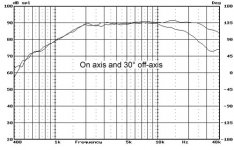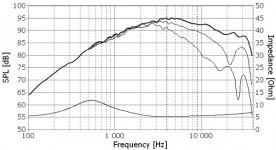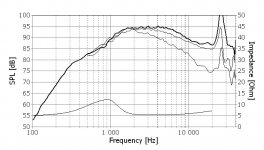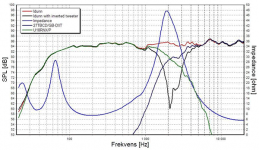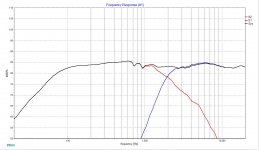I need some help understanding the concept of driver selection and obtaining “flat” or ideal system response. I have completed some kit builds where everything was worked out for me and I am now moving on to building from scratch. As I look at driver spec sheets and do some system modeling before parts selection I am getting pretty comfortable with looking for drivers that play well together and finding a logical crossover point and working the crossover design to compensate for baffle step and level matching issues, etc. I now better appreciate how hard it is to really nail a great design but I understand the moving parts involved reasonably well.
One thing that I don’t understand and surprised me is in looking at tweeter spec sheets. As you go up in price and reviews for all drivers you can see that the better drivers have flatter response or get the resonance further out of the way of the crossover points or have less cone break up, etc. i decided to keep going and look at some of the tweeters held in the highest regard and that cost hundreds of dollars and to my suprise some of them don’t have very flat response curves. Some even roll off towards 20k much more than a cheaper driver or slope up or down through the useable range.
I know that there is more to it than just reading spec sheets and to select components based on the spec sheet SPL curves but I need help to understand why a high end tweeter might have a response curve that is not as flat as a choice many times less cost. Does a high end tweeter sometimes sound better in part because it’s response is not flat and that this coloration helps it to sound smoother or more detailed for instance? Are these curves easier to integrate into the system design to get a flat system response. Are the spec sheets for lower end drivers less accurate with more smoothing making them look better but not real life?
Thanks,
George
One thing that I don’t understand and surprised me is in looking at tweeter spec sheets. As you go up in price and reviews for all drivers you can see that the better drivers have flatter response or get the resonance further out of the way of the crossover points or have less cone break up, etc. i decided to keep going and look at some of the tweeters held in the highest regard and that cost hundreds of dollars and to my suprise some of them don’t have very flat response curves. Some even roll off towards 20k much more than a cheaper driver or slope up or down through the useable range.
I know that there is more to it than just reading spec sheets and to select components based on the spec sheet SPL curves but I need help to understand why a high end tweeter might have a response curve that is not as flat as a choice many times less cost. Does a high end tweeter sometimes sound better in part because it’s response is not flat and that this coloration helps it to sound smoother or more detailed for instance? Are these curves easier to integrate into the system design to get a flat system response. Are the spec sheets for lower end drivers less accurate with more smoothing making them look better but not real life?
Thanks,
George
As a starter for ten, I will generalise which is always dangerous but ....
Flat responses can tend to sound, well.....flat. Ok, they reproduce what was recorded and as such can make bad recording sound bad and good recordings sound good but they are not well matched to the natural frequency sensitivity of the ear. Great if you are in a recording studio but not so great if you are listening in your lounge.
Research going back to the 80's by B&K seemed to show that most people have a propensity to subjectively like a "smiley face" frequency shape where there is a little boost at the bass and treble ends, I guess this matched the natural sensitivity which is highest in the mid band.
You may also find that, as an alternative to the smiley face, speakers can be often designed to have a gentle slope from bass to treble (3-6db from 20hz to 20khz) which again is agreeable to the ear. (TG often seems to favour this).
The easiest way to find out is to use an active dsp crossover where you can play around with the shape of the frequency profile (and correct for delay etc.) until you have the shape you and your ears like (look up minidsp). Once happy you can then reverse engineer into a passive crossover if you like, or just leave the dsp in there.
Just a few thoughts to start the discussion going.
Flat responses can tend to sound, well.....flat. Ok, they reproduce what was recorded and as such can make bad recording sound bad and good recordings sound good but they are not well matched to the natural frequency sensitivity of the ear. Great if you are in a recording studio but not so great if you are listening in your lounge.
Research going back to the 80's by B&K seemed to show that most people have a propensity to subjectively like a "smiley face" frequency shape where there is a little boost at the bass and treble ends, I guess this matched the natural sensitivity which is highest in the mid band.
You may also find that, as an alternative to the smiley face, speakers can be often designed to have a gentle slope from bass to treble (3-6db from 20hz to 20khz) which again is agreeable to the ear. (TG often seems to favour this).
The easiest way to find out is to use an active dsp crossover where you can play around with the shape of the frequency profile (and correct for delay etc.) until you have the shape you and your ears like (look up minidsp). Once happy you can then reverse engineer into a passive crossover if you like, or just leave the dsp in there.
Just a few thoughts to start the discussion going.
Congratulations, you have begun to probe the rabbit hole of driver performance and loudspeaker/crossover design. You seem to have a grasp of one of the primary goals of a loudspeaker, namely flat on-axis response. This is achieved both through driver selection, and crossover design.
But that is only the beginning and there are other factors to consider such as:
distortion performance as a function of frequency for a given driver
distortion performance as a function of SPL output
off-axis response of drivers and the loudspeaker's power response
Then when you are choosing a type of loudspeaker design to build, you should take into account:
the size of listening space
the acceptable size of loudspeaker
max SPL you desire for playback
Apart from the technical aspect of how to achieve your goal, loudspeaker design often involves balancing many tradeoffs that appear in all of these variables. At least there will be tradeoffs if you bother to look for them and consider more than flat on axis response.
So, getting back to your question about tweeters: the manufacturer may have tried to maximize some other performance aspect besides flat, extended response. They may have skewed the performance of the tweeter with a particular application in mind, and this might not make it "best" for another application. Also, you can only use the frequency response in a spec sheet as a rough guide. The response of the driver in the cabinet will be difference because the shape and size of the box and baffle are not the same as the MFGs testing conditions. This is why performing measurements as part of your design/build process is critical - you will then know the response of the driver in your exact cabinet and can design the crossover for it.
But that is only the beginning and there are other factors to consider such as:
distortion performance as a function of frequency for a given driver
distortion performance as a function of SPL output
off-axis response of drivers and the loudspeaker's power response
Then when you are choosing a type of loudspeaker design to build, you should take into account:
the size of listening space
the acceptable size of loudspeaker
max SPL you desire for playback
Apart from the technical aspect of how to achieve your goal, loudspeaker design often involves balancing many tradeoffs that appear in all of these variables. At least there will be tradeoffs if you bother to look for them and consider more than flat on axis response.
So, getting back to your question about tweeters: the manufacturer may have tried to maximize some other performance aspect besides flat, extended response. They may have skewed the performance of the tweeter with a particular application in mind, and this might not make it "best" for another application. Also, you can only use the frequency response in a spec sheet as a rough guide. The response of the driver in the cabinet will be difference because the shape and size of the box and baffle are not the same as the MFGs testing conditions. This is why performing measurements as part of your design/build process is critical - you will then know the response of the driver in your exact cabinet and can design the crossover for it.
In terms of FR;
- I tend to find smiley responses dull or overly neutral in the mids. The clarity in the mids just suffers.
- Tilted spectrally, I find the treble sparkle and air lacking. Orchestral instruments just sound dull, and realism suffers.
- Flat responses to me sound the most realistic, and do not sound 'flat' or wrong. Midrange is resolving and clear/open without being murky, and treble has good extension.
When you get flat-FR correct, nothing else sounds as good, IMO.
Wolf
- I tend to find smiley responses dull or overly neutral in the mids. The clarity in the mids just suffers.
- Tilted spectrally, I find the treble sparkle and air lacking. Orchestral instruments just sound dull, and realism suffers.
- Flat responses to me sound the most realistic, and do not sound 'flat' or wrong. Midrange is resolving and clear/open without being murky, and treble has good extension.
When you get flat-FR correct, nothing else sounds as good, IMO.
Wolf
In terms of FR;
- I tend to find smiley responses dull or overly neutral in the mids. The clarity in the mids just suffers.
- Tilted spectrally, I find the treble sparkle and air lacking. Orchestral instruments just sound dull, and realism suffers.
- Flat responses to me sound the most realistic, and do not sound 'flat' or wrong. Midrange is resolving and clear/open without being murky, and treble has good extension.
When you get flat-FR correct, nothing else sounds as good, IMO.
Wolf
Hear, hear!
Like what? 😉 He was referring to very expensive tweeters I think, and wouldn't they be for HiFi? I mean, it wouldn't be governed so much by cabinet or room, or would it? I could be missing something very obvious 😀So, getting back to your question about tweeters: the manufacturer may have tried to maximize some other performance aspect besides flat, extended response. They may have skewed the performance of the tweeter with a particular application in mind, and this might not make it "best" for another application.
Last edited:
In terms of FR;
- I tend to find smiley responses dull or overly neutral in the mids. The clarity in the mids just suffers.
- Tilted spectrally, I find the treble sparkle and air lacking. Orchestral instruments just sound dull, and realism suffers.
- Flat responses to me sound the most realistic, and do not sound 'flat' or wrong. Midrange is resolving and clear/open without being murky, and treble has good extension.
When you get flat-FR correct, nothing else sounds as good, IMO.
Wolf
Agree.
If you find anything other than a flat response sounds good, then you most likely have a problem elsewhere.
Large-scale (overall curvature) flatness or lack of it of the raw driver response is not a criterion for good driver. The fine-print is -- peaks and dips from resonances etc.
Overall curvature (in the final spaker) is easily established and the only thing the designer can manipulate anyway.
Overall curvature (in the final spaker) is easily established and the only thing the designer can manipulate anyway.
Here are two examples to illustrate my point:
First curve is a $19 HiVi and the second curve is a $546 Seas Excel.
George
There are aspects of the Seas frequency response that are better. Can you spot them?
As I mentioned before, unless you happen to be using the same conditions under which the MFG measured the driver, you will get a different (and non-flat) frequency response from the very same driver when used in your loudspeaker project. You can easily correct a peaking FR using the crossover, so don't put such a premium on "flat" MFG curves.
If you compare other performance metrics besides frequency response you will start to see some more compelling differences. The problem/challenge is that many of the other performance metrics I mentioned in post #3 are not published by the manufacturer. You have to measure them, or find someone who has. Also, after a bit of experience you will get a feel for what you can expect from a certain type of driver based on its construction and the reputation of the MFG.
Some drivers outperform their price point and represent a major bargain. Other drivers use exotic construction techniques, or command a premium because of their "pedigree", and are less of a bargain while still being of high quality (and priced that way). Some drivers perform quite differently than their MFG data sheet might suggest. Some drivers meet spec at 100mW but then fall apart at even modest power levels. Mostly the MFG data sheet will tell you very little about these other aspects of performance and is just a starting point.
Also, price should not really be a factor. Either you can afford it or you can't, and if you can't then don't worry about it!
"There are aspects of the Seas frequency response that are better. Can you spot them?"
No I don't see it, please help me understand.
Thanks,
George
No I don't see it, please help me understand.
Thanks,
George
The Seas driver has about 10dB more output at 1kHz. This may or may not translate into 10dB more maximum output capability, but I'm sure that it is going to be significantly higher. This allows a lower crossover frequency and/or just more overall SPL and/or lower distortion.
The Excel driver has higher average sensitivity. This allows more response shaping to be done in the crossover and will give the system higher average impedance. With tweeters, in general, it is better to have an overall falling slope than a rising slope. It requires less crossover components to fix this.
Problems I see.
The measurement of the first tweeter is massively smoothed. Run away from any curve that looks like this. They are hiding things. There is no reason to smooth measurements. It is just like grinding welds smooth. The only reason is to hide something.
The first tweeter doesn't have an impedance curve. You can't evaluate a driver without this. The impedance curves tells you a lot of things about the driver that can be hidden in a frequency response measurement.
There is also the issue of consistency. Buying an expensive driver doesn't guarantee this, but some some manufacturers, it greatly increases the chances of it. When you purchase an inexpensive driver, the odds are that it will not be as consistently manufactured. The first response curve above looks quite nice, but how many driver samples did they have to measure to find one which was this flat? Probably quite a few.
Without a doubt they are very expensive drivers that just aren't good, or at the very least aren't any better than a $25 driver at sound reproduction. Why do $1,000 pieces of speaker wire exist? Certainly not because they sound better. Drivers aren't going to be any different.
The Excel driver has higher average sensitivity. This allows more response shaping to be done in the crossover and will give the system higher average impedance. With tweeters, in general, it is better to have an overall falling slope than a rising slope. It requires less crossover components to fix this.
Problems I see.
The measurement of the first tweeter is massively smoothed. Run away from any curve that looks like this. They are hiding things. There is no reason to smooth measurements. It is just like grinding welds smooth. The only reason is to hide something.
The first tweeter doesn't have an impedance curve. You can't evaluate a driver without this. The impedance curves tells you a lot of things about the driver that can be hidden in a frequency response measurement.
There is also the issue of consistency. Buying an expensive driver doesn't guarantee this, but some some manufacturers, it greatly increases the chances of it. When you purchase an inexpensive driver, the odds are that it will not be as consistently manufactured. The first response curve above looks quite nice, but how many driver samples did they have to measure to find one which was this flat? Probably quite a few.
Without a doubt they are very expensive drivers that just aren't good, or at the very least aren't any better than a $25 driver at sound reproduction. Why do $1,000 pieces of speaker wire exist? Certainly not because they sound better. Drivers aren't going to be any different.
A flat smooth response is indeed desirable but what I look for is the harmonic distortion produced by the driver over it's workable bandwidth. Odd order harmonics, particularly the 3rd as it is generally more prominent than the 5th will largely determine the tonal expression of the driver. The 2nd harmonic which is more complementry with the fundamental will just add a bit of 'warmth' to the sound and is not obnoxious at all and is not problematic.
This is where a website like 'Hifi Compass' is so usable to DIY'er, the site offers harmonic distortion testing of drivers. There are other sites too but are not as extensive.
Measurements and compare | HiFiCompass
Two tweeters of interest............
SB Acoustics SB26ADC-C000-4 | HiFiCompass
a high quality tweeter that is relatively cheap
and the much more expensive.......
ScanSpeak D2905/970000 | HiFiCompass
As mentioned in a previous post the frequency response of a driver can be manipulated quite easily by the crossover but its inherent harmonic distortion is what gives it character.
C.M
This is where a website like 'Hifi Compass' is so usable to DIY'er, the site offers harmonic distortion testing of drivers. There are other sites too but are not as extensive.
Measurements and compare | HiFiCompass
Two tweeters of interest............
SB Acoustics SB26ADC-C000-4 | HiFiCompass
a high quality tweeter that is relatively cheap
and the much more expensive.......
ScanSpeak D2905/970000 | HiFiCompass
As mentioned in a previous post the frequency response of a driver can be manipulated quite easily by the crossover but its inherent harmonic distortion is what gives it character.
C.M
Continuing my quest to understand this, I looked at a Madisound kit (Idunn) using a Seas Tweeter with a similar "hump" in the data sheet response curve but a more modest price - 27TBCD/GB-DXT (H1499). The system response curve is much flatter than the tweeter spec sheet would suggest. As a matter of fact the individual curves also show a flatter tweeter. The crossover is fairly simple - 3rd order with L pad for the tweeter and a simple 2nd order for the mid. No BSC, no notch filters, etc. What accounts for the major difference between the tweeter spec sheet and the much flatter system curve?
Thanks,
George
Thanks,
George
Attachments
George,
This is a good example of why it is better to have a tweeter with a sloped down response. If you look at the high pass filter on the tweeter, I'm sure that theratio of L to C has been adjusted to make the Q of the filter very low. This compensates for the sloped down response of the tweeter from 5kHz to 10kHz and makes the electroacoustic response flat.
They probably don't publish this, but try to get a look at the crossover v-plots. That tells you a lot.
This is a good example of why it is better to have a tweeter with a sloped down response. If you look at the high pass filter on the tweeter, I'm sure that theratio of L to C has been adjusted to make the Q of the filter very low. This compensates for the sloped down response of the tweeter from 5kHz to 10kHz and makes the electroacoustic response flat.
They probably don't publish this, but try to get a look at the crossover v-plots. That tells you a lot.
I traced the driver curves, lifted the xover circuit, and massaged the numbers. I don't have the benefit of the actual drivers in the enclosure but I am pleasantly surprised at how relatively flat I can get the system response curve so a downward sloping raw tweeter curve can be massaged to work very well. Attached is what I came up with in 5 minutes.
Thanks,
George
Thanks,
George
Attachments
Last edited:
What accounts for the major difference between the tweeter spec sheet and the much flatter system curve?
Equalization.
To some extent, everything we do in a crossover is equalization. We are messing with the voltage or impedance, or both.
Sometimes the EQ is hidden in the high/low pass filters, sometimes it is a separate circuit.
For instance, baffle step compensation can be hidden via higher R coils and proper part selection. Others may use a separate baffle step circuit.
Best,
E
$546 Seas Excel. From the data sheet "A 7 mm thick precision die-cast aluminum front plate with moderate horn loading"
The key words "Horn Loading" This tweeter has a built in waveguide or horn that boosts the lower range. This is the desired result. It is expected that the user understands this and compensates for it. This horn gain allows the tweeter to play the lower frequencies with less cone excursion and therefore less distortion. I only came to appreciate this myself in the last few months as I looked at building some speakers with a well controlled radiation pattern or constant directivity.
Seas T29B001 Beryllium Dome Tweeter
The key words "Horn Loading" This tweeter has a built in waveguide or horn that boosts the lower range. This is the desired result. It is expected that the user understands this and compensates for it. This horn gain allows the tweeter to play the lower frequencies with less cone excursion and therefore less distortion. I only came to appreciate this myself in the last few months as I looked at building some speakers with a well controlled radiation pattern or constant directivity.
Seas T29B001 Beryllium Dome Tweeter
I kept seeing this tweeter used in several highly regarded speakers by KII Audio and Grimm and finally realized why the waveguide boosted low end was desirable and easy to equalize with a crossover filter. SEAS Prestige 27TBCD/GB-DXT (H1499) Tweeter
Last edited:
- Home
- Loudspeakers
- Multi-Way
- Drivers and flat response
